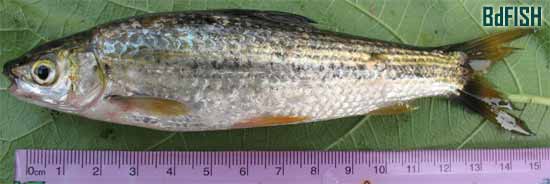
Systematic position (Nelson 2006)
Phylum: Chordata
Class: Actinopterygii (Ray-finned fishes)
Order: Cypriniformes (Carps)
Family: Cyprinidae (Carps and minnows)
Genus: Cirrhina
Species: C. reba
Synonyms
Labeo ariza (Hamilton, 1807)
Cirrhinus reba (Hamilton, 1822)
Gobio limnophilus (McClelland, 1839)
Gobio bovianus (Jerdon, 1849)
Common/Local names
Reba, Raik, Bata, Aikhor, Raikhor, Tatkini (Bangladesh)
Reba carp (English)
Reba (Fishbase)
Distribution: Bangladesh, India and Punjab (Bhuiyan 1964). Also in Nepal (Talwar and Jhingran 1991).
Conservation status: Vulnerable in Bangladesh (IUCN Bangladesh 2000)
Morphology: The body is elongated and laterally compressed. Dorsal profile more convex than that of abdomen. Mouth inferior and a pair of rostral barbels. Body covered with hexagonal scales. Silver body color. Scales are darkest at their upper and lower edges.
Maximum length reported 60 cm (Hamilton, 1822), 22 cm (Bhuiyan 1964), 32.5 cm (Rahman 1989), 30 cm (Talwar and Jhingran 1991) and 29.3 cm (Hussain, 1999). Highest length measured 23.5 cm in 2007 in the Chalan Beel of Bangladesh (Galib 2008).
Head 23.9% SL and 19.1% TL. Height 26.6% SL and 21.3% TL. Eye 24.4% HL. Lateral line present and complete with about 36-38 scales (Galib 2008).
Fin formula:
D. 24-26/30-49; A. 3/31-46; P. 19; C. 12 (Bhuiyan 1964)
D. 10-11 (2-3/8); P1. 16-17; P2. 9; A. 8(3/5) (Rahman 1989)
D. 32-39/74-90; A. 3/75-88; P. 23 (Shafi and Quddus 2001)
Habitat: All rivers and clear streams of Bangladesh (Bhuiyan 1964). Found also in tanks, canals, ponds, beels and inundated fields (Talwar and Jhingran 1991; Rahman 1989). Recorded in the Bookbhara Baor (Mohsin et al 2009), Chalan Beel (Galib et al 2009), Choto Jamuna River (Galib et al 2013) and Halti Beel (Imteazzaman and Galib 2013).
Food and feeding: Plankton and detritus feeder (Talwar and Jhingran 1991). Feed on mud, vegetables, crustaceans and insect larvae (Bhuiyan 1964). Food contents are algae (10%), higher plants (70%), protozoa (5%), crustaceans (10%) and mud and sands (5%) (Mookerjee et al., 1946)
Breeding: Breeds in the beginning of summer when there is excessive rainfall (Bhuiyan 1964). Between June-September, breeding found in flooded shallows (Talwar and Jhingran 1991).
Economics importance: Used as food fish in Bangladesh (Galib 2008).
Harvesting and marketing: Flesh is oily and tasteful and liked by the consumers (Rahman 1989).
_____________________________________________________________
References
Day F. 1878. Fishes of India: being a Natural History of the Fishes Known to Inhabit the Sea and Freshwater of India, Ceylon and Burma, Atlas in 4th part, London, 778 p.
Hamilton F (Buchanan). 1822. An account of the fishes found in the river Ganges and its branches, Edinburgh & London, Fishes Ganges, pp. 1-405.
Hamilton F. 1807. A journey from Madras through the countries of Mysore, Canara, and Malabar, London. Journey from Madras. pp. 1-479.
Hussain MM. 1999. Fishes and Fisheries of the River Atrai in Rajshahi with Reference to its Limnology, unpublished Ph.D. thesis, Department of Zoology, University of Rajshahi, Bangladesh, pp. 5-200.
Jerdon, T. C., 1849. On the fresh-water fishes of southern India. (Continued from p. 149.), Madras J. Lit. Sci., pp. 302-346.
McClelland, J., 1839. Indian Cyprinidae, Asiatic Researches, pp. 217-471.
Mookerjee HK, Sen Gupta SN and Roy Choudhury DN. 1946. Food and its percentage composition of the common adult food fishes of Bengal, Sci. & Cult. Calcutta, 12(7):247.
Visited 6,200 times, 1 visits today | Have any fisheries relevant question?
